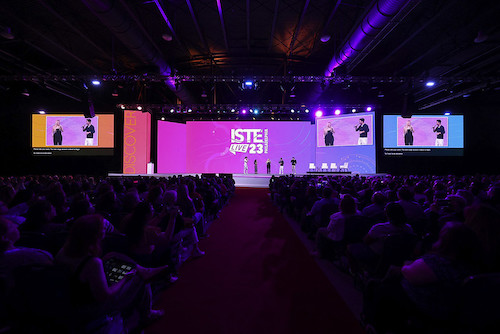Key points:
- While AI has its place in the classroom, humans–and their humanity–are a driving force
- There are 5 skills teachers should ensure students have as they move into a world full of AI
- See related article: Edtech leaders offer guidance on safe AI classroom integration
- Everything You Need To Know About AI In Education
What does it mean to be human in a digital world? At ISTELive 23, that question was central to the annual edtech conference’s focus on what’s happening in education—and what’s next.
“Four years ago, I made a prediction: I predicted that in five years, education would be completely transformed by two factors: a dramatic increase in connectivity, and a dramatic increase in the capabilities of AI,” said ISTE CEO Richard Culatta. “At that time, less than half the schools in the country were one-to-one, and nobody really knew what AI was. It’s interesting to think about where we are just four years later, and how this combination of increased connectivity and AI capabilities is totally changing our world. AI can do some pretty amazing things.”
While AI has exploded in recent months, it’s important to define its place in teaching and learning and identify the skills teachers and students will need as they move into this next generation of education. To that end, ISTE has released a number of resources and guides focused around AI in education.
Three questions have emerged as critical to this process:
- How can schools use AI to support student learning?
- How can AI support educators in teaching and in freeing up time?
- How can we prepare students with the skills they need to thrive in a digital and AI-infused world?
“That last one is one of the most important and also getting the least attention,” Culatta said.
There are five skills we need to be teaching our students for success in an AI world, he added:
1. Teach students how AI really works. Understanding is key to knowing its limitations; we need students to understand when it might be inappropriate to hand an important decision to AI because of the bias in the machine. But on the flip side, we need students to understand when it might be irresponsible NOT to hand an important decision off to AI. AI is a tool that can be used for good if we know how it works, and in order to do that, we need educators who understand how it works.
2. Teach students how to use AI to support brainstorming. As the world gets more complicated, the number of problems we have to answer grows exponentially. We need the ability to brainstorm 30, 40, or 50 solutions and choose the best one. Learning to be able to outsource the development and the brainstorming to AI and choose the best option is a critical skill.
3. Teach young people how to work on hybrid teams. Not teams split between those onsite and those at home, but teams that are part human and part AI.
4. Teach curation over creation. Schools are designed to teach students how to create. In a world where AI can be used to generate very quickly, is that the best use of a student’s time? We may worry that if we don’t have students come up with the solutions on their own, they might not be very smart. But perhaps it’s time to re-think the purpose of school and think about whether the skills of the future can–and should–be curating and recognizing the right response over generating it from scratch.
5. Of critical importance is the question of how we learn to be better at being human. One question we need to ask is: What’s the value of being human in an AI world? Humans have had a monopoly on decision-making, written language, and advanced reasoning for thousands of years. We’ve never had to justify what our value is. As AI begins to do some things better, make sure young people are really learning to exercise those skills that can’t be reproduced by a computer, including empathy, honesty, creativity, and civility.
Right now, the AI tools we’re using are generic. Nobody has yet trained an AI bot specifically for teachers and around teachers’ needs. The future of AI won’t be generic AI bots, but specialized AI that is designed to be deeply aware of particular contexts.
Related:
Is AI the future of education?
How AI enhances personalization in education
- Friday 5: Virtual field trips - April 26, 2024
- Google, MIT RAISE launch no-cost AI training course for teachers - April 26, 2024
- 4 ways to support work-based learning - April 23, 2024

